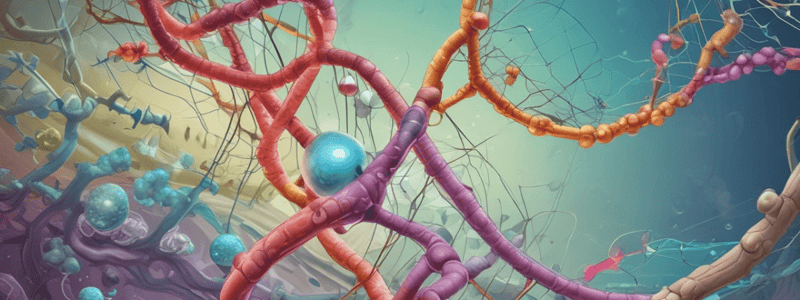Podcast
Questions and Answers
What is the primary function of nucleic acids in cells?
What is the primary function of nucleic acids in cells?
- To provide energy for cellular processes
- To synthesize proteins directly
- To store and express genetic information (correct)
- To regulate cell membrane permeability
What is the main difference between DNA and RNA?
What is the main difference between DNA and RNA?
- The function of protein synthesis
- The type of pentose molecule (correct)
- The number of nucleotides
- The presence of a phosphate group
What are nucleic acids composed of?
What are nucleic acids composed of?
- Nucleotides and biopolymers (correct)
- Carbohydrates and lipids
- Amino acids and proteins
- Minerals and vitamins
What is the role of phosphate groups in nucleotides?
What is the role of phosphate groups in nucleotides?
What is the common feature of both DNA and RNA?
What is the common feature of both DNA and RNA?
What is attached to the second and third carbon atoms in ribose?
What is attached to the second and third carbon atoms in ribose?
What type of bond is formed between the first carbon of the pentose sugar and the 9th nitrogen atom of a nitrogenous base?
What type of bond is formed between the first carbon of the pentose sugar and the 9th nitrogen atom of a nitrogenous base?
What is the purpose of ATP in the cell?
What is the purpose of ATP in the cell?
What is the function of RNA in protein synthesis?
What is the function of RNA in protein synthesis?
What is formed when two phosphate groups are removed from ATP?
What is formed when two phosphate groups are removed from ATP?
What is the role of ATP in the cell?
What is the role of ATP in the cell?
Who discovered DNA and from what sources?
Who discovered DNA and from what sources?
What is the function of tRNA in protein synthesis?
What is the function of tRNA in protein synthesis?
What is the purpose of nucleic acids?
What is the purpose of nucleic acids?
What are nucleic acids composed of?
What are nucleic acids composed of?
Flashcards are hidden until you start studying
Study Notes
Nucleic Acids
- Nucleic acids are macromolecules present in all cells and viruses, storing and expressing genetic information.
- There are two main types of nucleic acids: deoxyribonucleic acid (DNA) and ribonucleic acid (RNA).
Nucleic Acid Structure and Function
- Nucleic acids are biopolymers composed of nucleotides, each consisting of a phosphate group, a nitrogen base, and a pentose molecule.
- Phosphate group: a phosphorus atom bonded to negatively charged oxygen atoms.
- Pentose molecule: deoxyribose (DNA) or ribose (RNA), with five carbon atoms and one oxygen atom, with hydrogen atoms and hydroxyl groups attached.
- Nitrogen base: purines (adenine and guanine) and pyrimidines (thymine, uracil, and cytosine), which bind to carbon, hydrogen, and oxygen molecules to form ring structures.
Nucleotide Bonding
- Glycosidic bonds form between the pentose sugar molecule and the nitrogen base.
- Ester bonds form between the phosphate group and the pentose sugar molecule.
- Many nucleotides form a chain of nucleotides or polynucleotides to form DNA and RNA.
DNA Functions
- Stores and codes genetic information in the body.
- Allows for the inheritance of genetic traits from parents to offspring.
- Provides instructions for making proteins in an organism.
RNA Functions
- Plays a significant role in protein synthesis and controlling the expression of genetic information.
- Carries genetic information in some viruses.
- Participates in the creation of new cells, translation of DNA into proteins, and selection of amino acids to form new proteins.
- Three main types of RNA: transfer RNA (tRNA), messenger RNA (mRNA), and ribosomal RNA (rRNA).
ATP and Energy Production
- Adenosine triphosphate (ATP) is a molecule consisting of a nitrogenous base, a ribose sugar, and three phosphate groups.
- ATP generates energy for cellular processes, providing energy through the release of phosphate groups.
- ATP is synthesized in the mitochondria and is essential for cellular functions, such as protein transport and cytoskeletal maintenance.
Discovery of Nucleic Acids
- Friedreich Miescher isolated DNA from white blood cells in 1869 and named it "nuclein".
- Altmann, a student of Miescher, later named the molecule "nucleic acid".
- Albrecht Kossel isolated the chemical components of nucleic acids (cytosine, guanine, uracil, and thymine) between 1885 and 1901.
Studying That Suits You
Use AI to generate personalized quizzes and flashcards to suit your learning preferences.




